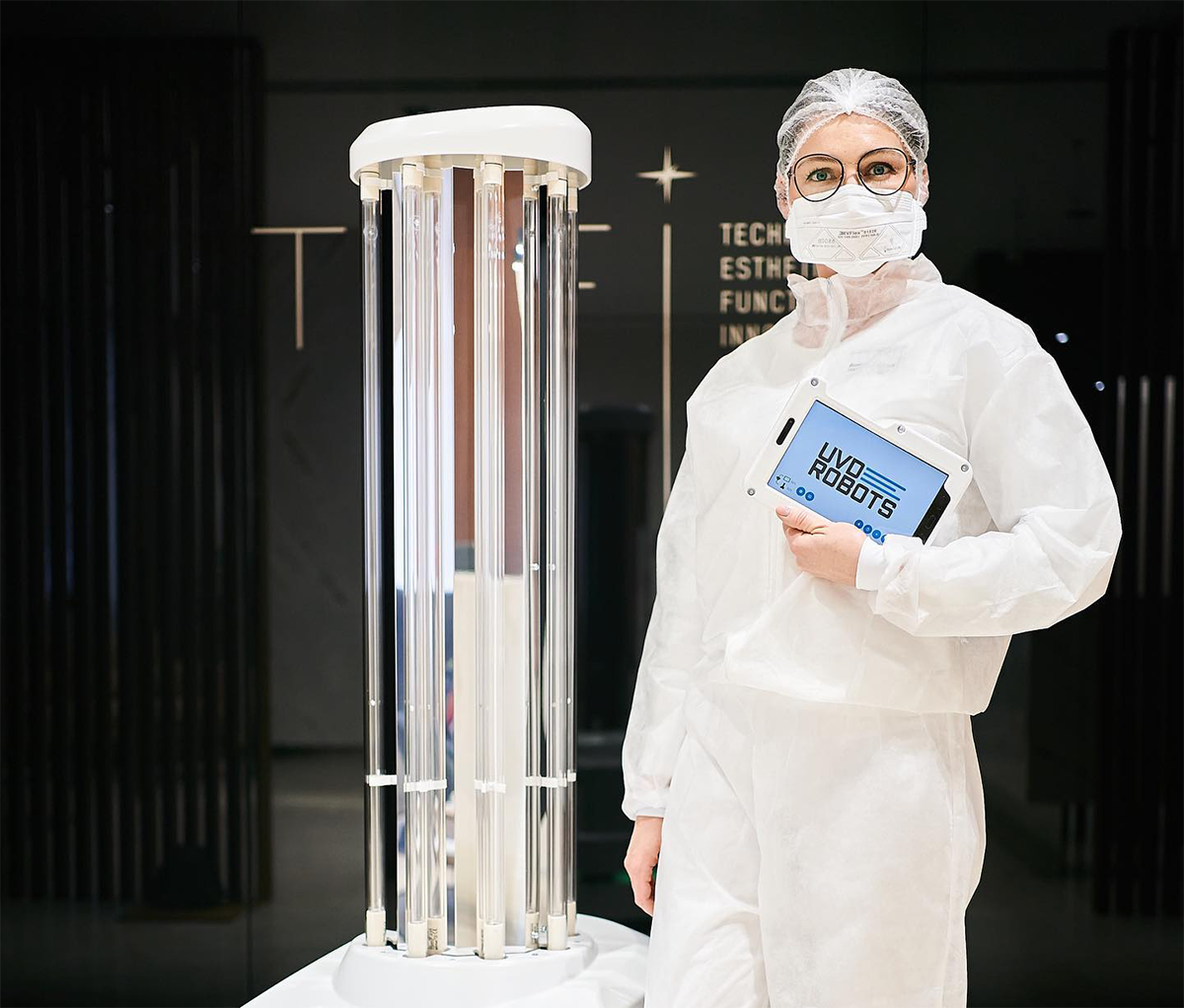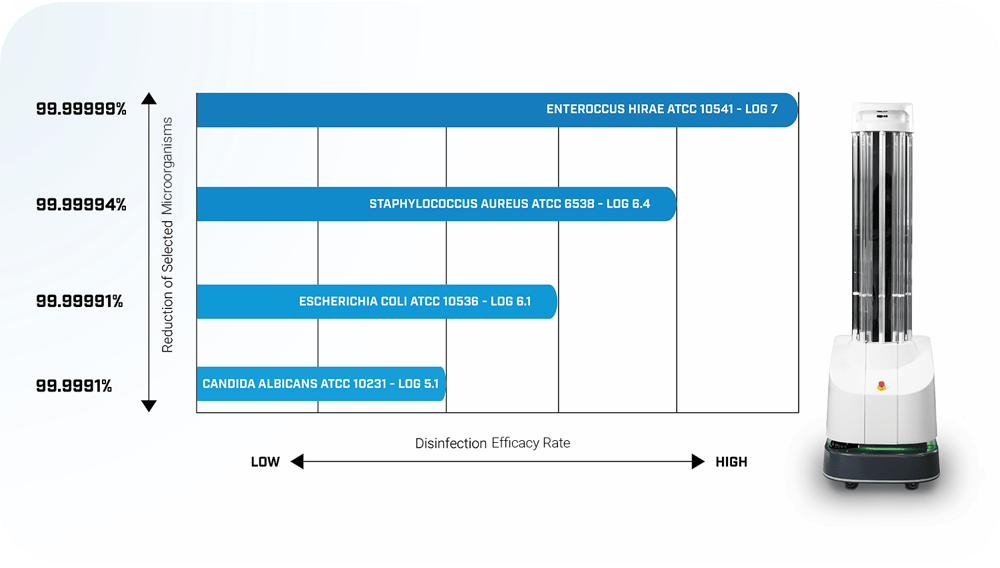Title
Content
Title
Content

Disinfecting indoor environments requires a means of measuring efficacy in reducing microorganisms. There is a specific way, however, to represent this efficacy in mathematical terms – and here is a closer look.
Environmental disinfection, or the process of decontaminating an area of microorganisms, is measured in terms of efficacy – or the measurement of the reduction of such organisms as expressed as a proportion.1 This proportion usually involves a comparison of ratios of the concentration levels of microorganisms before and after a disinfection process.
For example, if there is a concentration of 100 microorganisms present in an environment before a disinfection process, this concentration could be represented by the ratio 100/100, or 100%. If 75 microorganisms out of this original 100 are eliminated after the disinfection process, the reduction in concentration could be expressed by the ratio 75/100, or the decimal number 0.75, or 75%. Represented in terms of a proportion (an equation of the two ratios), the disinfection process would be considered to have a reduction efficacy of 75%.
Log reductions are expressed in mathematical notation, which can also be expressed as a certain percentage. This is because log reductions are put in terms of a logarithm, which is a function that inverts an exponential notation. For example, log10 (100) would be the way to represent a logarithm of 100. It is put in terms of base-10, which is the numeral seen in the subscript of log10(100).
In log10(100), the number 100 represents base-10 to the second power, or 2. Therefore, log10(100) = 2. This equation, as a logarithm, is an inverted function that expresses 100 = 102.
Logarithms are versatile because they can accommodate different base number systems (such as base-2 or base-5). In terms of log reductions, however, only base-10 is used. The concentration of microorganisms is represented in log reductions as n-log10, otherwise known as an n-log reduction.
The n-log reduction refers to the amount of the original concentration of microorganisms eliminated by a disinfection process. An n-log reduction is equivalent to the original amount of microorganisms, minus 10-n times the original amount of microorganisms. This figure is then divided by the original number and multiplied by 100, to express the reduction as a percentage.
For example, if the original number of microorganisms is 2000, a 2-log reduction would be ((2000 - (10-2 * 2000)) / 2000) * 100, or (1980/2000) * 100, or a reduction of 99% of microorganisms. If the original number is 2000 again, a 3-log reduction would be ((2000 - (10-3 * 2000))/2000) * 100, or (1998/2000) * 100, or a reduction of 99.9% of microorganisms.
A 4-log reduction would represent a reduction of 99.99% of microorganisms, a 5-log reduction would represent a reduction of 99.999% of microorganisms, a 6-log reduction 99.9999%, and so on.
In different environments, microorganisms can occur in very high exponential numbers. For example, a microorganism such as Escherichia coli is able to grow, in lab culture environments, to numbers as high as 1.89 * 108 (or 189 million) in just over 12 hours.2
These high numbers are the reasons why n-log reductions are useful in representing the percentage of microorganisms eliminated during a disinfection process. The higher the n-log number, the more likely a significant amount of a microorganisms are eliminated – possibly to the point of effective air, water, and surface disinfection.3
Indoor environmental disinfection methods may include chemicals, surface treatments, and/or manual cleaning. These methods, however, can not always be applied to all surfaces4, and because of this, alternate methods, such as Ultraviolet C (UV-C) light have been adopted in conjunction to manual cleaning methods to properly disinfect these environments.5
In terms of UV-C light solutions, 254 nanometer (nm) UV-C light has been found to achieve over 3-log to over 6-log reductions of certain microorganisms on surfaces and in indoor environments.6 7 In addition to this, the disinfection powers of UV-C light is often hindered by areas of shadow8, but can be improved by use of self-driving, or autonomous, systems.9
UVD Robots are an autonomous disinfection solution that use 254 nm UV-C light to reduce microorganisms in indoor environments. They are self-driving robots equipped with UV-C light sources that have been associated with over 3-log (99.9%) reductions.10
UVD Robots, when used in conjunction with manual cleaning and disinfection practices, have been associated with the elimination of microorganisms such as Staphylococcus aureus at rates of at least 99.9999%.11 This represents a high log efficacy rate (at least 6-log) in microorganism reduction.

Since environmental microorganisms appear in very high numbers, logarithmic reductions or log reductions are used to represent how thorough a decontamination process may be. Log reductions are expressed in an n-log format, which can be translated into a percentage format.
A 1-log reduction represents a reduction of 90% of microorganisms, a 2-log reduction represents 99%, a 3-log reduction represents 99.9%, and so on. Mobile and automated robotic UV-C light disinfection systems have been developed to minimize the effects of shadows and maximize log reduction efficacy.
UVD Robots are an autonomous disinfection platform that uses 254 nm UV-C light, and have been shown to have the potential to reach over 3-log (99.9%) reductions of microorganisms in indoor environments. With such systems, the outcomes of microorganism reductions are significant – and log reductions are an exceptional means to express disinfection efficacy.
1 Campanac, C., et al. "Interactions between biocide cationic agents and bacterial biofilms." Antimicrobial agents and chemotherapy 46.5 (2002): 1469-1474.
2 Créach, Véronique, et al. "Direct estimate of active bacteria: CTC use and limitations." Journal of microbiological methods 52.1 (2003): 19-28.
3 Mehta, Ishaan, et al. "UV disinfection robots: A review." Robotics and Autonomous Systems (2022): 104332.
4 Wallace, Rhiannon L., Marc Ouellette, and Julie Jean. "Effect of UV‐C light or hydrogen peroxide wipes on the inactivation of methicillin‐resistant Staphylococcus aureus, Clostridium difficile spores and norovirus surrogate." Journal of applied microbiology 127.2 (2019): 586-597.
5 Martínez de Alba, Angel Emilio, et al. "Microbiological evaluation of the disinfecting potential of UV-C and UV-C plus ozone generating robots." Microorganisms 9.1 (2021): 172.
6 Edwards-Jones, Val. "Assessment of UVD Robot Against Reduction of MultiDrug Resistant Klebsiella pneumoniae, Acinetobacter baumannii and Clostridium difficile on Surfaces." Essential Microbiology Ltd. and Melbec Microbiology Ltd., Apr. 2019, www.melbecmicrobiology.co.uk, www.essentialmicrobiology.com.
7 Andersen, Helle Stendahl. Analysis Report: Test of UV Disinfection Robot acc. NF T72-281. Report Number 754372_Rev. 2. Danish Technological Institute, 2020.
8 Endo, Tomonori, et al. "Discussion on effect of material on UV reflection and its disinfection with focus on Japanese Stucco for interior wall." Scientific reports 11.1 (2021): 1-9.
9 González, Carlos M. "Cleaning with UV light." Mechanical Engineering 143.1 (2021): 32-33.
10 Andersen, Helle Stendahl. Analysis Report: Test of UV Disinfection Robot acc. NF T72-281. Report Number 754372_Rev. 2. Danish Technological Institute, 2020.
11 Andersen, Helle Stendahl. Analysis Report: Test of UV Disinfection Robot acc. NF T72-281. Report Number 754372_Rev. 2. Danish Technological Institute, 2020.